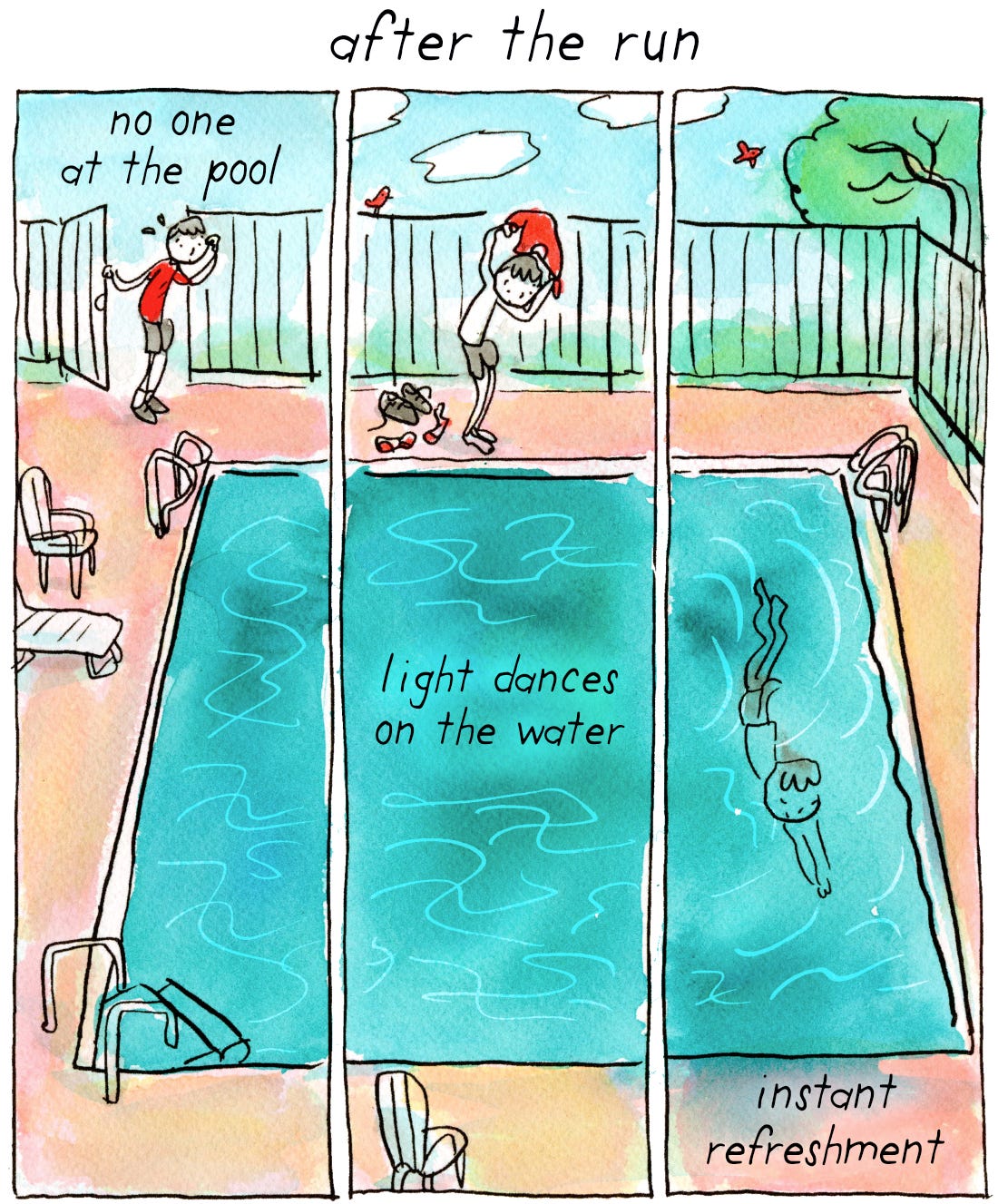The rules of haiku are simple: Three lines. Five syllables in the first line, seven syllables in the second, five syllables in the third.
Haiku reflect nature, show a particular occurrence, and often use a season word, or kigo, to evoke a specific time of year.
Here are some summer kigo:
My favorite haiku rule of all: The poem should be in the act of happening.
This rule calls for a poem:
Nowness is the thing
all poets try to capture
and fail to capture…Still, we keep trying.
What better way to try to capture summer’s moments than a daily poetry prompt?
So I started Haiku July. My rules for Haiku July are simple. One haiku poetry comic per day. Drawn from real life.
I’ve made haiku comics for my book POETRY COMICS, and I’ve explored some ways approaching the form in this newsletter post:
For Haiku July I gave myself an additional constraint: Learn how to paint.
It’s been a learning process. One day I hope to achieve the master watercolorist status of my twin brother, artist Gavin Snider. For now I’m pushing paint around the paper and seeing what happens.
But back to the writing.
Writing in my home office is a sedentary activity—one that can yield a cycle of procrastination, guilt, more procrastination, more guilt…
On days I struggle to start writing, it’s good to go outside and move.
I love to run. It gets me out in nature. It calms my brain. It summons ideas.
No ideas for get-rich-quick schemes, productivity hacks, or world changing inventions—but plenty of seventeen syllable insights.
Cycling is a good alternative to running. There’s a converted railroad track trail near my house I can follow for miles.
When I ride for long enough I often slip into the same hyper-aware state as I do while running.
Small details leap out before my eyes. My brain is a lens taking in the world with great clarity and focus.
If I remember to bring a notebook, I’ll stop on a trailside bench and scribble a few lines: sketches, poem fragments, ideas for future stories.
Sometimes my jottings look like gibberish when I return to them later. But often, a sketch becomes a comic, a poem fragment becomes a haiku, the hint of a story becomes a chapter.
Finally, I return from my workout, full of ideas and drenched in sweat.
(Sweat—a summer kigo!)
The neighborhood pool opens at 9 AM. The water is clear of teenagers and algae. Morning light illuminates the water. It looks like a poem.
I think I’ll indulge in a plunge.
Some Incidental Comics summer news and updates:
I’ll be at Comic-Con in San Diego to attend the Eisner Awards banquet—my book POETRY COMICS is nominated in the Best Publication for Early Readers category.
You can purchase signed copies of the book here, or find it online or at your favorite bookstore.
If you’re in San Diego for Comic-Con, come see me on the Abrams ComicArts panel at 3 PM Thursday. I’ll be talking about my new book of comics on complicated emotions, THINKING ABOUT THINKING.
This fall I’ll be part of the virtual Wild Wonder conference, where I’ll talk about making poetry comics from nature. There’s a fantastic lineup of speakers on all facets of nature journaling.
You can follow along with my daily Haiku July comics in my Notes.














Thanks Grant. Your July Haiku on Substack notes has inspired me to document my city (Mumbai) through photographs captioned with a Haiku. I am loving it so much. Here's to making sense of the world in 17 syllables!
Lovely work as always Grant! What you're creating can better be classified as Haiga, a now largely forgotten form where a painter makes a painting about a subject and writes a haiku on the same, upon the painting itself.